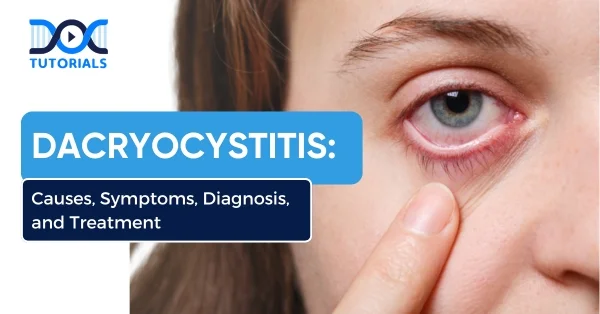Dacryocystitis: Causes, Symptoms, Diagnosis, and Treatment

Dacryocystitis is an infection or swelling of the lacrimal sac, which is a small pouch near the inner corner of the eye where tears generally escape. Most of the time, the nasolacrimal duct gets blocked, which causes fluid to build up and then a bacterial infection to develop.
Recognising the problem early and getting treatment right away are the best ways to avoid problems like an abscess or orbital cellulitis. Knowing about dacryocystitis is vital for both treating patients and for medical students taking competitive exams like NEET PG, where they often have to know a lot about the intricacies of eye diseases.
Keep reading for a detailed insight into the causes, symptoms, diagnosis and treatment of dacryocystitis.
What is Dacryocystitis?
Dacryocystitis is an infection and inflammation of the lacrimal sac, which is a key part of the tear drainage system that is located near the inner corner of the eye. Normally, tears that come from the lacrimal glands clean and lubricate the eyes.
They flow through minute pores in the eyelids called puncta into the lacrimal sac and then down the nasolacrimal duct to the nose. If this tear drainage system gets blocked, either in the sac, the duct, or the tubes that connect them, tears can build up, which can lead to bacterial development and infection.
This can be chronic dacryocystitis, which lasts a long time, or acute dacryocystitis, which comes on quickly. This cycle of obstruction and infection is what causes dacryocystitis and how it affects eye health.
What are the Causes of Dacryocystitis?
Dacryocystitis can be caused by a number of factors, including infections, anatomical problems, or lifestyle choices. These are the main causes:
- Bacterial Infections: The most prevalent cause of dacryocystitis is bacteria getting into the lacrimal sac, especially Staphylococcus aureus, Streptococcus pneumoniae, and Haemophilus influenzae. These germs thrive when the drainage of tears is blocked.
- Environmental Irritants: Exposure to airborne allergens, pollutants, or irritants can cause inflammation of the tear ducts, which makes you more likely to get an infection.
- Genetic Predisposition: Some people may inherit physical qualities or characteristics that make them more likely to have blocked tear ducts.
- Autoimmune Disorders: Sjögren’s syndrome is an autoimmune disease that causes persistent dry eyes and damage to the tear drainage system, which leads to blockage and a secondary infection.
- Lack of Hygiene: Not cleaning your face or eyes properly might cause bacteria to grow around your tear ducts.
- Smoking: Smoking can irritate the nasal and ocular mucosa, which can lead to inflammation and blockage of the ducts.
- Lack of Nutrients: A poor diet can make the immune system weaker and make the body more vulnerable to infections.
- Age Factors: People over 40 are more likely to have problems with their tear drainage system since it gets clogged or doesn’t work as well as it should.
- Gender: Women are more likely to be afflicted, which may be because the architecture of the nasolacrimal duct is different in women.
- Trauma or Nasal Surgery: Having had face trauma or surgery around the nose in the past may modify the structure of the tear ducts, which can cause blockages.
- Tumours or Strange Nasal Anatomy: Tumours or strange nasal anatomy can put pressure on or block the nasolacrimal duct.
- Certain Medications: Tear duct obstruction has been connected to drugs like timolol, pilocarpine, dorzolamide, trifluridine, fluorouracil, docetaxel, and radioactive iodine.
What are the Symptoms of Dacryocystitis?
The symptoms of dacryocystitis are different for people who have had it for a long time and for people who have had it for a short time. These are the main signs of this condition:
- Eye Pain and Tenderness: A common sign is sensitivity or pain at the inner corner of the eye that gets worse when you touch or blink.
- Swelling: Skin above the lacrimal sac area that is swollen or raised because of localised inflammation.
- Skin Redness or Discolouration: The skin around the area becomes noticeably red or darker, which is a sign of irritation or inflammation.
- Excessive Tearing (Epiphora): Tears that can’t drain properly overflow and run down the face all the time.
- Discharge: Pus or mucus coming out of the inner corner of the eye, especially when you put pressure on the lacrimal sac.
- Abscess Formation: If left untreated, a localised pus-filled abscess might form at the site of the swelling.
- Watery Eyes: The most common complaint is that tears keep coming, even when there is no swelling or redness.
What is the Diagnosis of Dacryocystitis?
A combination of clinical evaluation, specialised tests, and imaging is used to diagnose dacryocystitis and find out what caused the tear duct blockage:
- Clinical Evaluation: The diagnostic examination begins with a close look at the patient’s medical history and symptoms. This includes any history of eye or nose problems, recent illness, and current complaints of tearing, swelling, or discharge.
- Physical Examination: The healthcare practitioner examines the eye, especially the area around the lacrimal sac, for symptoms of redness, irritation, and swelling. If you gently press on the punctum and pus or mucus comes out, that is very strong evidence of infection.
- Eye Examination: A regular eye exam is done to check the overall health of the eye, find any problems with vision, and see if there are any secondary problems caused by inflammation or chronic tear stasis.
- Imaging Tests: You might need an X-ray or CT (computed tomography) scan to look at the tear ducts and the structures around them. These show any problems with the body’s structure, sinusitis, or consequences like abscesses.
- Dacryocystography: This is a specific imaging test that includes injecting dye into the tear drainage system to provide a clear picture of blockages and narrowing in the lacrimal duct or sac.
- Blood Tests: The doctor may use blood tests to find out what is causing the eye problem.
What is the Treatment for Dacryocystitis?
Antibiotics are usually used to get rid of the infection in the dacryocystitis treatment. Here are several ways to treat dacryocystitis:
- Warm Compresses: Putting warm compresses on the inflamed eye can help with pain and swelling.
- Antibiotics: Doctors usually provide oral or topical antibiotics to people who have bacterial infections that cause dacryocystitis.
- Nasolacrimal Duct Probing and Irrigation: This method uses a tiny, flexible probe to remove the blockage and clean up any debris or infection in the tear duct.
- Dacryocystorhinostomy (DCR) Surgery: This operation makes a new conduit for tears to drain by going around the clogged tear duct. A tiny cut is performed near the nose to make a new opening between the tear sac and the nasal cavity.
- Endoscopic Dacryocystorhinostomy (endoDCR): This operation is not very invasive and employs an endoscope to look at and check the tear duct. Like DCR, it makes a new drainage path, but through a smaller hole.
FAQs About Dacryocystitis
- How much time does it take for dacryocystitis to cure?
Acute dacryocystitis symptoms show up fast and usually get worse than those of chronic dacryocystitis. However, with the right antibiotic, the symptoms usually go away in less than three months (often in just a few days).
- At what age does dacryocystitis typically occur?
Dacryocystitis usually affects 2 age groups: infants due to birth defects and people over 40 because of blockages that happen later in life. It is more usual to notice it soon after birth or later in life, especially in those who are middle-aged or older.
- What are the clinical stages associated with dacryocystitis?
If the infection isn’t treated, it can get worse and lead to cellulitis, the formation of an abscess, and the creation of a fistula that drains pus either outside the body or into the nasal cavity.
- How can dacryocystitis be prevented?
Using saline spray to clean your nose might help keep the distal lacrimal outflow from getting blocked. Sometimes, warm compresses and eyelid washes can help keep some cases of dacryocystitis from happening.
- What complications can arise from dacryocystitis treatment?
Dacryocystitis treatment is usually safe, although in certain situations it can cause bleeding, infection, sinusitis, or unintentional damage to neighbouring eye or nasal tissues.
Conclusion
Dacryocystitis is a common but serious disorder that causes the lacrimal sac to become inflamed or infected. This usually happens because the nasolacrimal duct is blocked.
Recognising its symptoms, such as discomfort, redness, and discharge, along with the correct diagnostic tests, such as imaging and regurgitation testing, makes it possible to give quick and efficient therapy.
DocTutorials help NEET PG candidates do well in clinically integrated subjects in their medical syllabus. Join DocTutorials today and explore our NEET PG course to excel in your medical career.
Latest Blogs
-

NEET PG Exam 2025- Date, Pattern, Marking Scheme, Subject Wise Weightage, and Exam Mode
NEET PG Exam 2025 is the ultimate gateway for medical graduates aspiring to pursue postgraduate courses in medicine, including MD,…
-

INI CET Exam 2025: Your Roadmap to Success – Key Topics, Strategies, and Lessons from Last Year’s Papers
The INI CET exam is more than just a test; it’s a significant milestone for many medical students aiming to…
-

INI CET Exam Success: Previous Year Question Papers & Ultimate Guide – INI CET PYQ
One can feel overwhelmed while preparing for the INI CET (Institute of National Importance Combined Entrance Test). A vast syllabus,…




